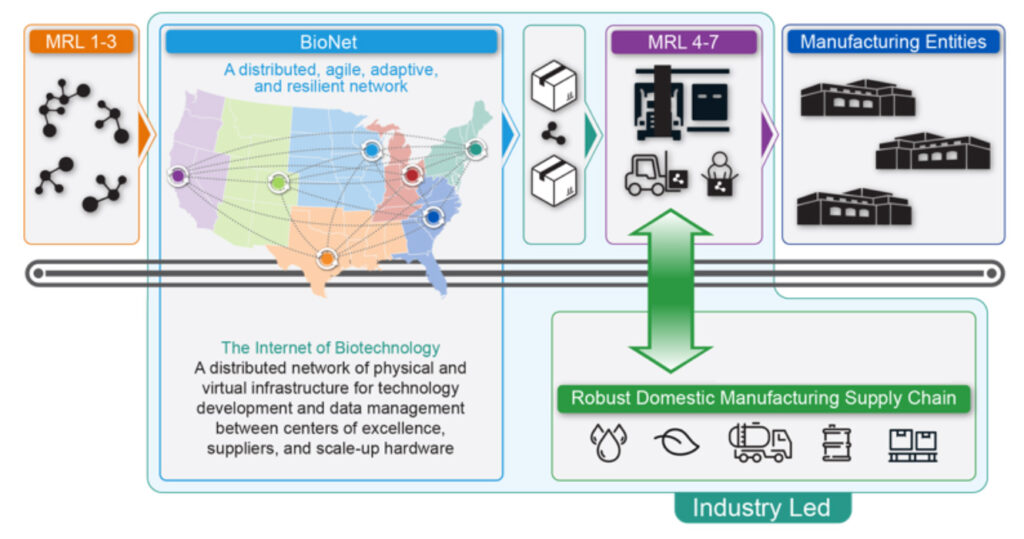Sponsored Content
The future of United States industrial growth, a key component of national security, rests in the establishment of biotechnology as a new pillar of industrial domestic manufacturing. It would enable delivery of robust supply chains and revolutionary products such as materials, pharmaceuticals, food and energy.
Traditional centralized manufacturing is brittle and unable to deliver new products that leverage unique attributes of biology. It does not enhance national economic impact or best use national raw materials/resources and does not maximize innovation enabled by the unique workforce distributed across the United States.
Sponsored By

What’s more, in an era of supply chain disruptions due to international competition, climate change and pandemic-sized threats (both known and unknown), centralized approaches that constitute a single point of attack or failure and necessarily restricted, localized economic impact are themselves a huge risk.
The opportunity exists to develop the science, infrastructure and workforce to establish what can be dubbed an industrial BioNETWORK to advance domestic distributed biomanufacturing, strengthen U.S.-based supply chain intermediaries, provide workforce development for underserved communities and achieve our own global independence and viability in biomanufacturing.
Implementing the BioNETWORK to create an end-to-end distributed biomanufacturing platform will fulfill the Executive Order on Advancing Biotechnology and Biomanufacturing Innovation and White House Office of Science and Technology Policy (OSTP) Bold Goals for U.S. Biotechnology and Biomanufacturing.
New federal policy approach needed
Biotechnology harnesses the power of biology to create new services and products, and the economic activity derived from biotechnology and biomanufacturing is referred to as the bioeconomy.
While federal government support for biotechnology and the bioeconomy has increased with recent executive orders and policy papers, the overarching concepts are broad. They do not provide actionable steps for the private sector to respond to and do not provide the proper organization and goals that would drive outcomes of real manufacturing, resulting in processes or products that directly impact consumers.
A new program must be developed with clear milestones and deliverables to address the main challenges of biomanufacturing.
What’s wrong with centralized biomanufacturing
Centralized biomanufacturing is less secure and does not deliver on the full potential of biotechnology because it is:
- Reliant on a narrow set of feedstocks and reagents that are not local, introducing supply chain vulnerabilities that can halt bioproduction in its earliest steps of manufacturing.
- Inflexible for determining the most effective, stable, scalable and safe methods of biomanufacturing needed for multiple products in large facilities.
- Serial in scheduling, which introduces large delays in production and limits capacity and product diversity.
- Bespoke and not easily replicated when it comes to selection and design of microbial strains, cell free systems and sequences of known function outside of the facility that made them. Scale-up and reproducibility of biomanufacturing products are limited.
- Creating waste streams because circular economies are not leveraged.
- Vulnerable to personnel shortages due to shifting economic, health or other circumstances related to undertraining of a biotechnology specialized workforce.
National security risks
Single point failures in centralized manufacturing are a root cause of product disruptions and are highlighted by current events. The COVID-19 pandemic revealed that point failures in the workforce or raw materials created disruptions in the centralized manufacturing, and availability of hand sanitizers, rubber gloves, masks, basic medicines and active pharmaceutical ingredients impacted every American.
International conflict with China and other adversarial countries has also created vulnerabilities in the sole source access to rare earth metals used in electronics, batteries and displays, driving the need for alternate options for manufacturing that do not rely on single points of supply.
To offset this situation, the United States has access to workforce, raw materials and waste streams geographically distributed across the country that can be harnessed by biomanufacturing to produce both health and industrial products needed by U.S. consumers. However, currently there are only limited distributed manufacturing infrastructure development efforts to locally process those raw materials, leaving societal, economic and unrealized national security risks on the table. Nation-scale parallel production in multiple facilities is needed to robustly create products to meet consumer demand in health, industrial, energy and food markets.
A decentralized and resilient network
The BioNETWORK would invert the problem of a traditional centralized biomanufacturing facility and expertise paradigm by delivering a decentralized, resilient network enabling members to rapidly access manufacturing facilities, expertise and data repositories. It does this by integrating the substantial existing U.S. bioindustrial capabilities and resources to maximize nationwide outcomes.
The BioNETWORK should be constructed as an aggregate of industrial, academic, financial and nonprofit entities, organized in six regionally aligned nodes (see figure below for notional regional distribution) of biomanufacturing infrastructure that together form a hub network that cultivates collaboration, rapid technology advances and workforce development in underserved communities. The BioNETWORK’s fundamental design and construction aligns with the need for new regional technology development initiatives that expand the geographical distribution of innovative activity in the U.S., as stated in the CHIPS and Science Act.

Note: In the above graphic, MRL refers to the Manufacturing Readiness Level.
The BioNETWORK would act as the physical and information layer of manufacturing innovation, generating market forces and leveraging ubiquitous data capture and feedback loops to accelerate innovation and scale-up necessary for full-scale production of novel biomaterials, polymers, small molecules or microbes themselves.
As a secure network, BioNETWORK would serve as the physical and virtual backbone of the constituent biomanufacturing entities and their customers, providing unified, distributed manufacturing facilities, digital infrastructure to securely and efficiently exchange information/datasets, and enabling automated process development.
Together the nodes function in an integrated way to adaptively solve biotechnology infrastructure challenges as well as load balancing supply chain constraints in real-time depending on the need. This includes automated infrastructure provisioning of small, medium, or large biomanufacturing facilities, supply of regional raw materials, customization of process flow across the network, allocation of labor, and optimization of the economic effectiveness. The BioNETWORK also supports the implementation of a national, multi-tenant cloud lab and enables a systematic assessment of supply chain capabilities/vulnerabilities for biomanufacturing.
The benefits of a BioNetwork
Networked solutions are resilient and enduring. A single factory is at risk of transfer to foreign ownership, closure or obsolescence. The BioNETWORK would create connectivity among distributed biomanufacturing physical infrastructure to form a network with a robust domestic value chain.
Today’s biomanufacturing investments suffer from the need to vertically integrate due to lack of flexible capacity across the value chain, which raises capital requirements and overall risk. The BioNETWORK would drive horizontal integration through the network nodes via new infrastructure, connecting physical infrastructure of the nodes within the system. The result is a multi-sided marketplace for biotechnology innovation, products, and commercialization.
The federal government should initiate a new program and select performers to begin the research, development, and construction of the first three nodes of the BioNETWORK.
Taking action to establish the BioNETWORK ensures that the United States has the necessary physical and virtual infrastructure to grow the bioeconomy and its international leadership in biotechnology. The BioNETWORK would create new job opportunities for people across the country where training in biotechnology expands the skill sets of people with broad-spectrum applicability from trades to advanced degrees. The BioNETWORK would drive circular economies where raw materials from rural and urban centers enter the network and are transformed into high-value products such as advanced materials, pharmaceuticals, food, and energy.
The BioNETWORK would protect U.S. supply chain resiliency through distributed manufacturing and links regional development into a national capability to establish biomanufacturing as a pillar of economic and technological growth for today and into the 22nd century.
For more information about Battelle’s work in this area, contact Katy Delaney at DelaneyK@battelle.org
###







